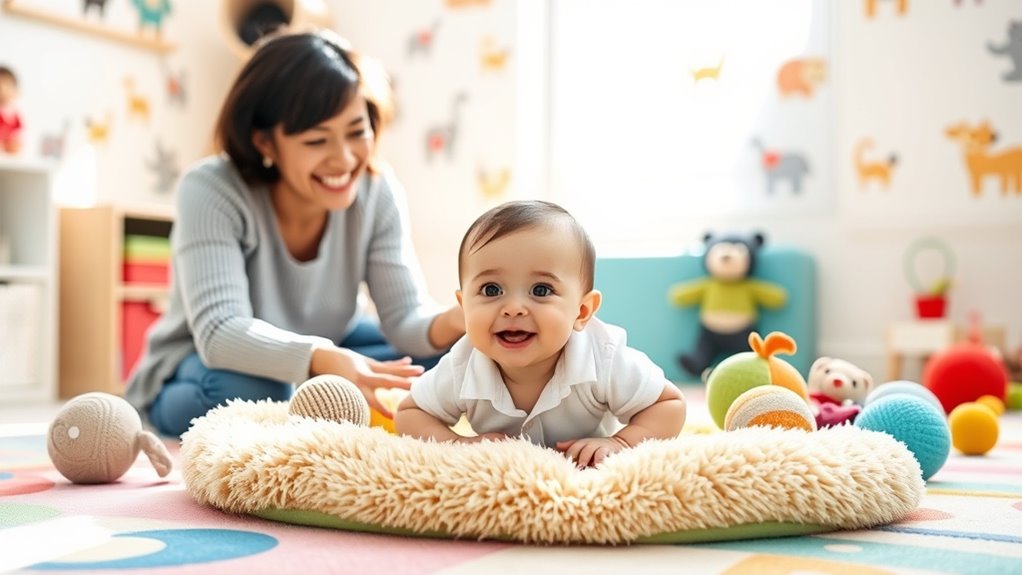To help your baby learn to sit up, start with tummy time to strengthen their neck and back muscles. Gradually introduce assisted sitting techniques, such as using your lap for support. Encourage reaching for toys while seated, and make sure they have plenty of floor time to explore. Create a safe environment with cushions for extra stability. With patience, your baby will gain the strength needed for independent sitting. Keep going to discover more helpful tips!
Key Takeaways
- Encourage tummy time to strengthen neck and back muscles, essential for developing the ability to sit up independently.
- Use assisted sitting techniques, like lap support or placing the baby between your legs, to provide stability while they practice sitting.
- Gradually reduce support around the ribcage as the baby gains strength and confidence in their sitting ability.
- Introduce engaging toys to motivate the baby to reach while sitting, enhancing core strength and balance.
- Ensure a safe, hazard-free environment with plenty of floor time for exploration and practice of independent sitting.

Teaching your baby to sit up is an exciting milestone in their development. Most babies typically learn to sit independently between 6 to 9 months of age, and you can help prepare them for this new skill. Start by focusing on building muscle strength through activities like tummy time. This essential exercise strengthens their neck and back muscles, providing a solid foundation for sitting. Make sure to supervise closely during tummy time, gradually increasing the duration as your baby grows stronger.
Head control is crucial before your little one can sit up. Encourage this by engaging them in various activities that promote sensory integration. Babies need to receive sensory feedback to adjust their body position and maintain balance. You can also help develop their proprioception, which is their understanding of body position and movement. When they’ve got good head control and muscle strength, they’re ready to start practicing sitting.
For assisted sitting techniques, you might begin by providing lap support, holding your baby in a sitting position on your lap. Alternatively, you can place them between your outstretched legs for added stability. Support their ribcage or trunk with your hands to help maintain their posture. As they grow stronger, gradually reduce your support, allowing them to find their balance. You can introduce dynamic sitting by gently tilting them to improve their core strength.
Encouraging independent sitting can be fun! Use toys to motivate your baby to reach for them while sitting. Surround them with cushions for safety and support, and consider using Boppy pillows for extra stability. Allow plenty of floor time for exploration, and remember, patience is key. Every baby develops at their own pace, so give them the time they need.
During supported sitting stages, start with full support around their ribcage and gradually move your hands down as they gain strength. They may naturally adopt tripod sitting, using their hands for balance. Offer them toys to look at, rather than grasp, during prop sitting to keep them engaged. You can even practice stability with less support as they progress.
Incorporate dynamic sitting activities by tilting your baby gently or using an exercise ball for fun. Always focus on strengthening their core muscles through movement. Ensure you create a safe environment, free from hazards, using cushions to prevent falls. Supervise your baby closely, and limit time spent in restrictive seats. With your love and guidance, your baby will be sitting up confidently in no time!
Frequently Asked Questions
What Age Do Most Babies Start Sitting up Independently?
Most babies start sitting up independently between 6 to 9 months old, though some might surprise you by doing it as early as 4 months.
By 9 months, most should be able to sit up unassisted.
Keep in mind that every baby develops at their own pace, so if your little one isn’t sitting up by then, it’s a good idea to consult a healthcare provider for guidance and support.
Is It Safe to Use a Baby Seat for Support?
Using a baby seat for support can be safe, but you need to ensure your baby is developmentally ready.
Make sure the seat allows for proper spinal alignment and hip positioning. It’s crucial to supervise your baby while they’re in the seat and never rely on it as the primary means for teaching them to sit.
How Long Should I Practice Sitting With My Baby Each Day?
Think of practicing sitting like training for a mini marathon. You wouldn’t sprint the whole way, right? Instead, you’d pace yourself.
Similarly, aim for short sessions throughout the day, just a few minutes at a time. As your baby grows stronger, gradually increase the duration, but always watch for cues to take breaks.
Mix in tummy time and fun activities to keep it engaging, ensuring your little one stays interested and energized!
Are There Toys That Can Help My Baby Learn to Sit?
Absolutely! Toys can be great tools to help your baby learn to sit.
Use reachable toys to encourage your little one to stretch and balance while sitting. Activity cubes can engage them and motivate them to remain upright.
Look for toys with sounds or lights to stimulate their senses and keep them interested. Hanging toys or mirrors can also captivate their attention, promoting the desire to sit and play.
What Signs Indicate My Baby Is Ready to Sit Up?
To know if your baby’s ready to sit up, watch for key signs.
Check if they can hold their head steady without bobbing and show interest in sitting by trying to lift themselves.
Look for signs of core strength, like bearing weight on their arms during tummy time.
If they can sit briefly with support or reach for toys while sitting, they’re likely developing the skills needed for sitting independently.
Conclusion
Teaching your baby to sit up is like nurturing a young tree; with patience, support, and the right environment, it’ll grow strong and steady. Just as you’d stake a sapling to help it stand tall, be there to catch your little one as they wobble and sway. Celebrate each tiny victory, and remember that with every attempt, they’re gaining strength and confidence. Soon enough, they’ll be sitting up like a pro, ready to explore the world around them!









